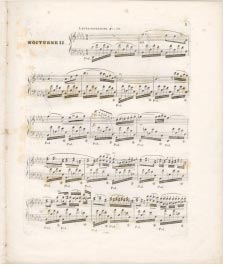The Secret Life of
Musical Notation: Defying Interpretive
Traditions
- Amadeus Press
Based on years
of research and performance, and
presenting original discoveries that
have generated groundbreaking insights, The
Secret Life of Musical Notation:
Defying Interpretive Traditions -
the inaugural book by pianist Roberto
Poli - was released in October 2010
by Amadeus Press. "Without question,
it is the most significant work on
piano playing to come along
in decades - savvy, pragmatic, ingenious,
and clearly written", says pianist,
author and music critic John Bell
Young.
"Every music
student learns conventions of musical
notation that are generally taken
for granted - for example, that an
expanding hairpin indicates an increase
in volume, or that a sforzando is
a sharp accent," explains Poli. "But
can we be sure that such instructions
meant the same in the eighteenth
and nineteenth centuries as they
do today?" Poli argues that
longstanding interpretations of certain
commonly encountered musical signs
and symbols, in works from as early
as the 1770s and through the nineteenth
century, may fail to reveal the composers'
intended meanings. According to Poli,
these misconstrued readings are due
to interpretive traditions that have
rested largely upon received knowledge,
which can change over time, rather
than historical accuracy; and that
a greater awareness of the intended
meanings can only bring us closer
to the interpretive freedom necessary
for artistic creation.
 Young
continues: "Certainly, though
I have played and performed for more
than forty years all the music
that Poli so judiciously evaluates
in these invaluable pages, I found
myself looking at interpretive issues
with a new eye and ear. He has not
only resolved for me a number
of long-standing interpretive challenges,
but he has also enhanced the pleasure
of piano playing itself." Poli's
first book tracks the path of his
discoveries from his years as a teenage
pianist to the present, when, as
a mature artist, he builds his case
on evidence from contemporary published
editions, manuscripts, letters and
other writings of the time. What
emerges is a powerful challenge to
conventional wisdom about how we
play classical music. Young
continues: "Certainly, though
I have played and performed for more
than forty years all the music
that Poli so judiciously evaluates
in these invaluable pages, I found
myself looking at interpretive issues
with a new eye and ear. He has not
only resolved for me a number
of long-standing interpretive challenges,
but he has also enhanced the pleasure
of piano playing itself." Poli's
first book tracks the path of his
discoveries from his years as a teenage
pianist to the present, when, as
a mature artist, he builds his case
on evidence from contemporary published
editions, manuscripts, letters and
other writings of the time. What
emerges is a powerful challenge to
conventional wisdom about how we
play classical music.
 Award-winning
writer and professor of history at
Boston University, James H. Johnson
says: "Poli's discoveries reveal
errors in today's standard editions
and cast doubt on assertions by such
authorities as the renowned author
and pianist Artur Schnabel and his
contemporary counterpart Charles
Rosen. In my view, his conclusions
will cause musicians to reevaluate
fundamental assumptions regarding
conventional elements of musical
expression. What makes this material
exciting? I would read it as akin
to a revelation, as if the brush
of generations of misreading were
suddenly cleared for a pristine view.
The effect is natural and simplifying." Award-winning
writer and professor of history at
Boston University, James H. Johnson
says: "Poli's discoveries reveal
errors in today's standard editions
and cast doubt on assertions by such
authorities as the renowned author
and pianist Artur Schnabel and his
contemporary counterpart Charles
Rosen. In my view, his conclusions
will cause musicians to reevaluate
fundamental assumptions regarding
conventional elements of musical
expression. What makes this material
exciting? I would read it as akin
to a revelation, as if the brush
of generations of misreading were
suddenly cleared for a pristine view.
The effect is natural and simplifying."
The Secret
Life of Musical Notation: Defying
Interpretive Traditions is
a must-read for scholars, performers,
and teachers of music and for anyone
interested in exploring the history
and meaning of musical notation.
Says again John Bell Young: "One
thing is for sure, which Roberto
Poli proves admirably in his book:
One is never too old nor too assured
to learn something new, or to take
to heart advice which, in the end, ought
help any musician worth his
salt achieve the primary objective, and
that is to make music with
the thoughtfulness and compassion
it deserves."
Join The Secret
Life of Musical Notation on
Facebook! 
|

From
Chapter Two - "...of
Sforzandi" (p. 70)
[...]
Working with one of my students on
the middle movement of Haydn’s
Sonata in E-flat Major Hob. XVI/49
brought back memories...


From
Chapter Three - "...of
Rinforzandi" (p. 103)
When asked
to describe the role of a rinforzando
that has been placed at the end
of a crescendo whose destination
is an fff, quite a few musicians...


From
Chapter Three - "...of
Rinforzandi" (p. 115)
[...]
Mozart did introduce rallentando,
and the earliest traceable examples
emerge in 1785 in pieces such as
the Fantasie in c minor, K. 475 and...


From
Chapter Five - "...of
Stretti" (p. 181)
Rather accidentally,
the subject of this chapter took
shape as I was comparing pedal markings...

|

